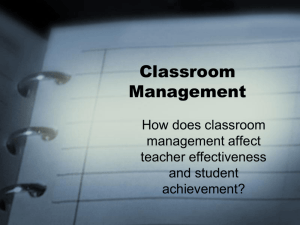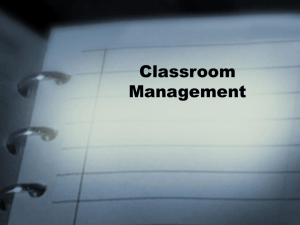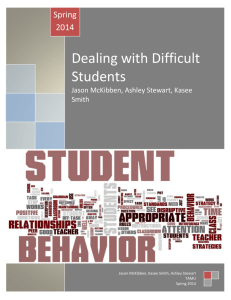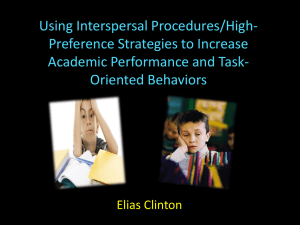Classroom Management Strategies
advertisement
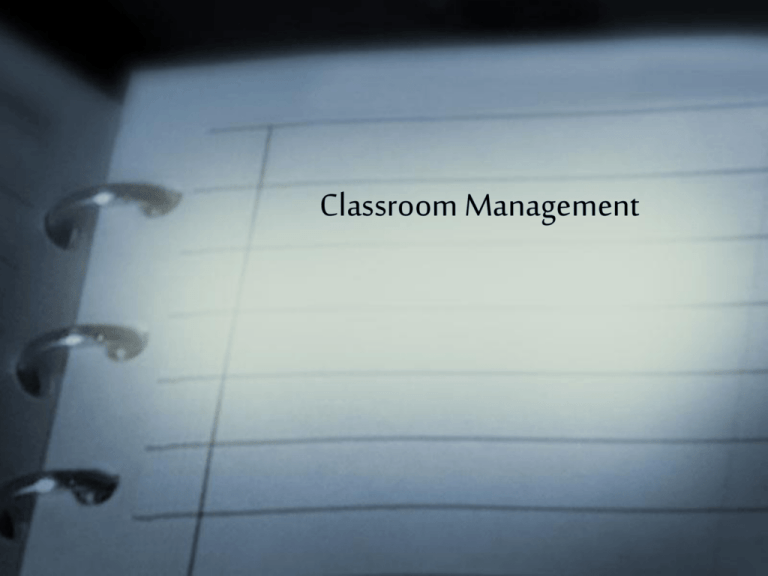
Classroom Management What is Classroom Management? – It’s effective discipline – It’s being prepared for class – It’s motivating your students – It’s providing a safe, comfortable learning environment – It’s building your students’ self esteem – It’s being creative and imaginative in daily lessons – And . . . . . . It’s different for EVERYONE!! WHY? – Teaching Styles – Personality/Attitudes – Student population – Not all management strategies are effective for every teacher • Try different strategies to see if they work for you Why is Classroom Management Important? • Satisfaction and enjoyment in teaching are dependent upon leading students to cooperate • Classroom management issues are of highest concern for beginning teachers Principles for successful classroom management • Deal with disruptive behaviors but also manage to minimize off-task, non-disruptive behaviors • Teach students to manage their own behavior • Students learn to be on-task and engaged in the learning activities you have planned for them – It is more natural to be off-task than on Techniques for Better Classroom Control • • • • Focus attention on entire class Don’t talk over student chatter Silence can be effective Use softer voice so students really have to listen to what you’re saying • Direct your instruction so that students know what is going to happen Techniques for Better Classroom Control • Monitor groups of students to check progress • Move around the room so students have to pay attention more readily • Give students non-verbal cues • Engage in low profile intervention of disruptions • Make sure classroom is comfortable and safe Techniques for Better Classroom Control • Over plan your lessons to ensure you fill the period with learning activities • Come to class prepared • Show confidence in your teaching • Learn student names as quickly as possible Withitness • Withitness refers to a teacher’s awareness of what is going on in the classroom Withitness • When handling misbehavior – make sure all students learn what is unacceptable about that behavior • Getting angry or stressed does not reduce future misbehavior • Deal with misbehavior without disrupting the learning activity Jones’ study of off-task behaviors • 99% of off-task behaviors take one of several forms – Talking out of turn – Clowning – Daydreaming – Moving about without permission • Antisocial, dangerous behaviors make up a fraction of the time students spend off-task Proximity and Body Language • Eye contact, facial expressions, gestures, physical proximity to students, and the way you carry yourself will communicate that you are in calm control of the class and mean to be taken seriously. • Be free to roam • Avoid turning back to class Cooperation through communication • Verbalize descriptions of behaviors and never value judgments about individuals • Verbalize feelings but remain in control • DO NOT USE SARCASM • Do not place labels (good or bad) • Do not get students hooked on praise – Praise the work and behavior – not the students themselves • Speak only to people when they are ready to listen Classroom Rules For Conduct • Formalized statements that provide students with general guidelines for the types of behaviors that are required and the types that are prohibited • A few rules are easier to remember than many rules • Each rule in a small set of rules is more important than each rule in a large set of rules Necessary classroom rules of conduct • Maximizes on-task behaviors and minimize off-task (esp. disruptive) behaviors • Secures the safety and comfort of the learning environment • Prevents the activities of the class from disturbing other classes • Maintains acceptable standards of decorum among students, school personnel, and visitors to the school campus Establishing a “Businesslike” Atmosphere . . . Or, “Don’t Smile until Christmas” A Businesslike Atmosphere • Take advantage of the first days of class • Establish an environment in which achieving specified learning goals takes priority over other concerns • It is much easier to establish this environment from the beginning rather than later 5 steps 1. 2. 3. 4. 5. Take advantage of the new school year or term to set the stage for cooperation Be particularly prepared and organized Minimize transition time Utilize a communication style that establishing nonthreatening, comfortable environment Clearly establish expectations for conduct Beginning a new year • Take advantage of initial uncertainty” • PLAN for a favorable beginning • Use learning activities with easy-to-follow, uncomplicated directions Room arrangement • Make sure all students can see and hear clearly (and you can see them clearly) • Arrangement is determined by learning activity (lecture, class discussion, small group work, etc.) • Allow room and easy access for proximity control • Think through class procedures and learning activities and arrange the room in the best possible way Dealing with misbehavior Functions of Behavior • Every behavior has a function • Four primary reasons for disruptive behavior in the classroom – – – – Power Revenge Attention Want to be left alone (i.e., disinterest or feelings of inadequacy) Functions of Behavior • Many misbehaviors exhibited by students are responses to a behavior exhibited by the teacher • Do not tolerate undesirable behaviors no matter what the excuse • Understanding why a person exhibits a behavior is no reason to tolerate it • Understanding the function of a behavior will help in knowing how to deal with that behavior Dealing with off-task behaviors • Remain focused and calm; organize thoughts • Either respond decisively or ignore it all together • Distinguish between off-task behaviors and off-task behavior patterns • Control the time and place for dealing with off-task behavior • Provide students with dignified ways to terminate offtask behaviors Attention Seeking Behavior • Attention-seeking students prefer being punished, admonished, or criticized to being ignored • Give attention to this student when he or she is on-task and cooperating • “Catch them being good!” – and let them know you caught them Power Seeking Behavior • Power-seeking students attempt to provoke teachers into a struggle of wills • In most cases, the teacher should direct attention to other members of the class

